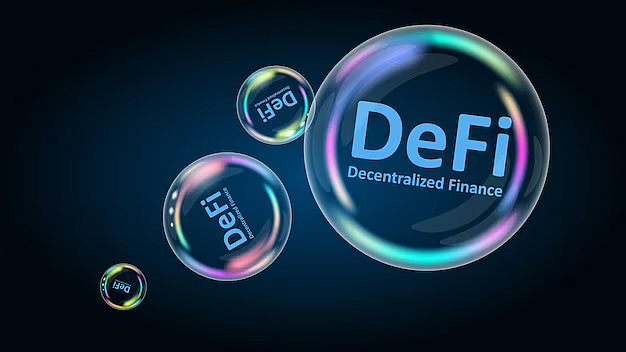The most revolutionary finance tech of the last several years has been decentralized finance—or DeFi. The offspring of blockchain technology and a vision of decentralization, DeFi upends conventional banking and financial institutions by offering open, permissionless, and trustless financial products to anyone with an internet connection. As of the writing of this book in 2025, billions of dollars' worth are locked up in DeFi protocols, powering a humongous lending, borrowing, trading, saving, and more ecosystem, all middlemen-free.
This piece will take a close examination of what precisely DeFi is, how it operates, its major aspects, the pros and cons it carries, and what precisely its emergence means for the world of finance in the years to come. If you're a crypto newbie, or perhaps someone who's taken a toe-dip into digital currency, this guide aims to de-mystify the secrets and possibilities of DeFi.
What is DeFi? A Paradigm Shift in Finance
Decentralized Finance (DeFi) is a financial product based on open blockchains like Ethereum, Binance Smart Chain, and Solana. Unlike traditional finance, DeFi does not need middlemen institutions like banks and brokers to facilitate financial transactions. Instead, it uses smart contracts—software programs with set rules for what to do—and which automatically implement on blockchain networks in an effort to satisfy financial contracts.
This means that consumers can lend and borrow assets, trade tokens, earn interest on deposits or purchase insurance, all through decentralized applications (dApps). Without middlemen, DeFi seeks to democratize access to financial services, cut fees, and increase transparency.
How Does DeFi Work? The Building Blocks of a Trustless System
Essentially, DeFi relies on smart contracts and blockchain. The most prevalent platform used for carrying out DeFi is Ethereum, but other platforms have also started getting used more intensely. All the transactions that are carried out on them are kept on the blockchain, thereby becoming secure and transparent.
Smart contracts constitute the foundation of DeFi operations. Smart contracts execute the transactions automatically upon fulfillment of pre-agreed conditions. For instance, in a lending protocol, a smart contract will disburse collateral and borrowed funds as agreed among the users without the intervention of a central party.
The other pillar of DeFi is the use of stablecoins—cryptocurrency tokens whose value is stabilised to the value of fiat assets like the US dollar. Stablecoins get rid of the volatility that usually comes with cryptocurrencies and make DeFi apps more stable and useful for economic uses.
Liquidity pools and automated market makers (AMMs) matter too. Decentralized trading is facilitated by these architectures through enabling users to offer liquidity in exchange for fees. Examples include Uniswap and SushiSwap, which are founded on this paradigm, instead of the traditional order-book-based exchanges.
Key Categories and Use Cases in DeFi
One of the best advantages of DeFi is how diversified its environment is. Each application solves different financial demands, many times complementing each other quite well. The main categories are:
Decentralized Exchanges (DEXs), which enable users to exchange cryptocurrencies directly out of their portfolios. Unlike centralized exchanges like Binance or Coinbase, DEXs do not keep users' funds, lessening the opportunity for hacks or mismanagement.
Borrowing and Lending Platforms such as MakerDAO, Compound, and Aave enable users to lend tokens and receive interest or borrow tokens by putting up collateral. These platforms are algorithmic in their operation, determining interest rates and percentages of collateral without any human intervention.
Yield Farming and Liquidity Mining are emerging as the new mainstream phenomena where users participate to earn passive income. Users can be rewarded with other tokens upon locking their tokens into DeFi protocols, essentially aiding the platform's growth.
Synthetic Derivatives and Assets receive exposure to real assets such as stocks, commodities, or fiat currencies. Initiatives such as Synthetix allow one to build and exchange synthetic representations of such assets on the blockchain, widening the DeFi arena.
Insurance Protocols target minimizing the risk of DeFi interaction. Products such as Nexus Mutual and InsurAce protect against smart contract failure, exchange hack, or other danger.
Benefit of DeFi: Enabling the Individual
DeFi has several good advantages over conventional finance. First and foremost, it is accessible. Provided that one owns an internet-connected smartphone, they are able to use DeFi platforms anywhere in the globe, no matter their income level or their banking history. This is especially critical for the globe's unbanked or underbanked.
Transparency is also a main benefit. All transactions on a blockchain are public and can't be modified, removing corruption or fraud potential. Users control their money at all times, never having to trust someone else.
DeFi systems operate around the clock, 24/7, with no banking days or holidays. Settlement periods often are seconds or minutes, not days as in traditional systems. Innovation is just as fast in DeFi. Composability and open-source software protocols allow developers to build upon what already exists in an effort to create new, better financial products. That builds culture and constant iteration.
Challenges and Risks: The Other Side of the Coin
For all its potential, though, DeFi has its flip sides. One of the most glaring is probably security. Smart contracts as advanced as they are are based on the software that executes them being as advanced as well. Bugs or glitches in the code can be used to trick the system, and a substantial financial loss can be incurred. Celebrity hacks have lost tens of millions of dollars, disenfranchising investors.
Regulatory uncertainty also casts a shadow over the DeFi ecosystem. Governments and banks are still finding out how to classify and regulate decentralized systems like this. Such lack of clearly defined legal frameworks is difficult for both users and developers.
Volatility is another significant risk. While stablecoins mitigate some of the volatility, the whole crypto market is highly volatile. Price plummeting will trigger liquidations on lending platforms, with customers losing their collateral as asset prices drop.
DeFi protocols also have scalability and gas fee problems, especially on Ethereum. During periods of peak demand, fees are exorbitantly high and mass-participation not an option. Layer 2 solutions and other chains are attempting to fix it, but these come at a cost too.
Besides, the user experience in DeFi is still complex. Management of private keys, interaction with wallets, understanding of yield strategies, and understanding dApps all have a high entry bar, hopefully deterring potential users.
DeFi vs. Traditional Finance: A Comparative Perspective
In order to fully grasp the revolutionary potential of DeFi, it's useful to compare it to traditional finance. Banks and insurance companies, stock exchanges and payment providers have been the mainstay of the financial system for centuries. Yet their design is based upon central control, bureaucratic oversight, and intermediaries to provide trust and compliance.
DeFi, by contrast, is decentralized, open-source, and programmatic. Banks traditionally would take days to complete a transaction or grant a loan for regulatory reasons and processing within. In DeFi, a user can borrow a collateralized loan in minutes through a smart contract—no paperwork, no credit checks, wait time.
In addition, access is limited in traditional finance. Services are geography-dependent, economic class-sensitive, political regime-sensitive, and institution-sensitive. DeFi eliminates such limitations. A Kenyan farmer, an Argentine freelancer, or an Indian student can all use the same protocols as a New York hedge fund.
Whereas traditional finance continues to benefit from years of infrastructure investment, legal acclamation, and comparatively stable regimes, limitations of it in terms of innovation, transparency, and inclusion are being confronted head-on by DeFi platforms.
Read more: Can DeFi and Traditional Finance Coexist? A Hybrid Future Explained
DeFi Innovations Redefining Financial Architecture
In addition to replicating traditional financial products and services, DeFi is innovating radically new financial instruments and paradigms.
Flash Loans:
These are collateralless loans in which borrowing and repayment occur within one blockchain transaction. While dangerous, flash loans make possible intricate arbitrage and trading strategies hitherto off-limits to retail traders. They are examples of DeFi's experimental spirit and innovative use of programmable money.
Rebasing Tokens and Algorithmic Stablecoins:
Certain DeFi projects have also introduced rebasing tokens, which automatically rebalance supply in users' wallets to keep the price stable. Others have worked on algorithmic stablecoins that rely on code-based market mechanisms to keep pegs to fiat currencies. They are new types of money with dynamic supply characteristics.
Tokenized Real-World Assets:
Increased momentum is developing in tokenizing legacy assets such as real estate, bonds, or paintings. These tokenized assets can subsequently be exchanged or pledged on DeFi platforms, which enhances asset liquidity and ownership transparency.
Social Tokens and Community DeFi:
Certain communities and creators are also coming out with their own tokens that hold value within a particular community or ecosystem. It can be used for governance, tipping, membership, or even collateral. It's a blend of DeFi and creator economies and social identity.
Risks in Depth: Not Just Technical, but Psychological and Systemic
Whereas the dangers of smart contract defects and market fluctuations are commonly recognized, DeFi also poses deeper systemic issues that go underappreciated.
Economic Incentive Misalignments:
Numerous DeFi protocols base their user bases on token emissions. These rewards can lead to temporary participation with no long-term attachment. Users can leave in droves once rewards evaporate, leading to liquidity crises or protocol failure—a phenomenon sometimes referred to as "yield hopping" or "rug pull fatigue."
Regulatory Arbitrage and Grey Areas:
Certain projects deliberately evade regulation by being completely decentralized or pseudonymous. This encourages innovation but at the same time entices scams, legal ambiguity, and conflict with international regulators who still do not know how to classify decentralized systems that possess no CEO, headquarters, or legal person.
Ponzi Schemes Disguised as Innovation:
Sustainable yield is not guaranteed. A few prominent DeFi projects have presented dazzling APYs that proved to be unsustainable or simply criminal. New entrants, lured in by buzz, tend to serve as exit liquidity for previous users. This speculative environment harms the long-term reputation of DeFi.
Loss of Private Keys and Self-Custody Responsibility:
DeFi places the user completely in control of their funds—but also completely responsible. To lose a wallet's private key is complete and irreversible loss of access. There's no password reset, no customer support. For new users, this degree of responsibility is intimidating and can result in loss by mistake instead of by fraud.
The Road Ahead: Institutional DeFi and Regulation
The future chapter of DeFi will probably be defined by its interaction with institutional actors and regulators.
Large financial institutions already are testing DeFi as a complement to their current offerings. Some are becoming plugged into decentralized exchanges or creating permissioned DeFi products—systems that hold some decentralized logic but within a regulated, controlled environment. This hybrid model could speed DeFi adoption without sacrificing oversight.
Regulatorily, there are numerous nations actively crafting legal definitions of DeFi. Careful regulation has the potential to improve user security and bring in wider investment, but excessive repression might kill the DeFi space.
Compliance procedures like "Know Your Customer" (KYC) on-chain, decentralized identity solutions, and audited smart contracts are under development to build a safer and institutionally more acceptable DeFi ecosystem.
Read more: The Rise Of Institutional Participation In DeFi: Unlocking A New Era Of Finance
DeFi and the Next Generation of the Internet: Web3
DeFi is another key element in the broader context of the Web3 movement—an internet that is owned and operated by users through decentralized technologies. In Web3, users own their data, control their identities, and can monetize their online participation through tokens and NFTs.
DeFi builds the financial foundation for Web3, allowing users to buy, invest, and engage economically in decentralized social networks, games, metaverses, and content platforms. Your wallet such as MetaMask or Phantom becomes your password for finance as well as internet activity. Protocols connect to each other and create a multi-layered digital economy that is not limited by national borders or corporate control.
This overlap implies that DeFi is not merely an alternative finance opportunity—it is a building block for a new model of internet-based infrastructure.
Read more: Tokenized Real-World Assets in a Web3 World: Bridging the Physical and Digital Economies
The Role of Governance in DeFi
DeFi is generally governed by token holders that vote on fundamental protocol choices. The democratic model often involves governance tokens—cryptocurrencies that entitle voters to vote. Token holders such as UNI (Uniswap) or COMP (Compound) holders can vote on and suggest alterations to the protocol, such as fees, new functionalities, or collaborations.
Although this model encourages decentralization, it can sometimes result in power concentration. Whales—big holders of governance tokens—may disproportionately sway decisions, questioning real decentralization and equality.
To counter this, a lot of projects are testing quadratic voting, reputation systems, or decentralized autonomous organizations (DAOs) that seek to share governance more evenly.
Read more: Why Governance Matters in DeFi Protocols
Education and Awareness: Bridging the Knowledge Gap
The potential of DeFi can be fulfilled only if users know how to explore this new financial terrain. Education plays a vital role in enabling users to make sound choices, steer clear of scams, and interact with protocols safely. Several DeFi initiatives now spend money on educational material, user manuals, simulation platforms, and community forums to facilitate learning.
Content creators, educators, and influencers also play a significant role in demystifying DeFi. From YouTube tutorials to newsletters and podcasts, there are now countless resources available for those looking to deepen their understanding.
As DeFi continues to evolve, staying informed becomes essential—not only to seize opportunities but to avoid risks.
Conclusion: DeFi as a Catalyst for Financial Transformation
DeFi is not just a technological advance—it's a philosophical movement toward openness, equity, and economic autonomy. By bypassing middlemen and trusting code and communities, DeFi gives people power that was once unimaginable.
But this power carries with it responsibility. The DeFi space is still nascent, experimental, and susceptible to growing pains. Users need to come with curiosity but also with caution. Developers need to focus on security and usability. Regulators need to try to understand and not stifle.
As the boundaries between traditional finance and crypto become increasingly blurred, DeFi is leading the charge in a new world. Whether it succeeds in transforming world finance or creates an alternative universe for digital natives, one thing is certain—its impact will be profound and enduring.
In a world ever more characterized by digital interconnectivity and suspicion of centralized systems, DeFi presents an attractive vision of money's future. The technology exists. The momentum is growing. The question is now: will the world be prepared to welcome it?





















